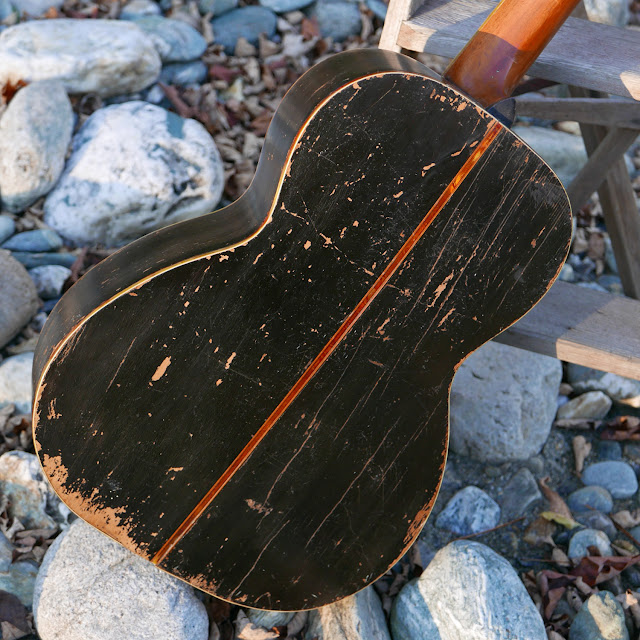1910s B&J University Parlor Guitar
Update 2017: This guitar came back via trade and I've since updated the blog post where necessary with new pictures, description, and a soundclip. I've given it a fresh refret and setup with 46w-10 strings and it's sounding good and playing great.
This handsome guitar is slightly smaller than a Martin 0 with 13 1/4" lower bout and a more squashed body. It's branded "Univeristy" and was sold through B&J (Buegeleisen & Jacobsen, a big instrument sales outfit), but my guess is that this is Chicago-made and probably has a connection with Lyon & Healy.
This handsome guitar is slightly smaller than a Martin 0 with 13 1/4" lower bout and a more squashed body. It's branded "Univeristy" and was sold through B&J (Buegeleisen & Jacobsen, a big instrument sales outfit), but my guess is that this is Chicago-made and probably has a connection with Lyon & Healy.
The bracing, body shape, neck shape, headstock shape, and overall build remind me most of nicer Lakeside and plainer Washburn instruments which were both concurrent Lyon & Healy brand lines at the time. No matter the origin, though, this was a little fancier than normal for the time (probably late teens), but solidly a "mid-range" model.
It has rather fancy detailing -- lots of purfling and inlaid stripes and lots of celluloid, which at the time was a novelty and seen as fancy -- and nicer-than-usual materials. The neck is Spanish cedar (as opposed to poplar or birch which most Chicago makes used), the top is solid spruce, the headstock has a rosewood veneer and the fretboard (under all that celluloid) is actually rosewood, too. The original bridge was rosewood as well but was cracked up. The back and sides on this appear to be stained birch.
I'd purchased this guitar almost a year ago (2012) but let it sit for a long time because I was reluctant to start in on it. Some silly fool had poorly reglued (if you can call it that) the endblock so there was a lot of undoing to get started on repairing that and while it's structurally secure, it's not pretty down there. Other work included a new rosewood bridge and ebony pins, a neck reset, seam repairs, center seam top cleats, a refret (fresh in 2017), general cleaning, and setup. I also drop-filled a number of pretty stable back hairline cracks.
It plays on-the-dot at 3/32" EA and 1/16" DGBE action at the 12th fret. I've strung it with 46w-10 strings (the max of what I'd suggest on this).
It plays on-the-dot at 3/32" EA and 1/16" DGBE action at the 12th fret. I've strung it with 46w-10 strings (the max of what I'd suggest on this).
The nut is original and bone and has a 1 3/4" width. The board profile is flat and the neck's rear is a medium V-shape that's more comfortable than average for the time (it's a bit like a concurrent Martin shape/size but a little deeper). It has a short, 24 1/4" scale.
While this was probably strung with gut or nylon to begin with it seems to have been used with steel most of its life without adverse neck effects. It has a great tone for folky fingerpicking or blues and nails that sort of punchy-but-warm ragtime tone as well.
The third dot is a replacement. Check out that cool yellowy-orangey pearloid on the board -- really fun stuff. The frets are modern "medium" stock (since 2017) which I had to glue in place and then level/dress a bunch to get "right." Pearloid boards can be finicky to work on as they tend to get a concave portion in the center as the veneer shrinks. It's good to go, now, though.
The three-ring rosette is really sweet! I love how this guitar is edged and bound everywhere with that faux-tortoise celluloid. It really grabs the sun nicely when this is out in it. Don't you also love all that half-herringone?
The new rosewood bridge is compensated for good intonation. I used some nice ebony pins on this guy, too.
The sides have tons of scuffs and scratches and scrapes and finish wear but don't have any cracks.
The tuners are all-original except for two gears and machine screws which I had to replace as they were missing. They're lubed and work just fine.
The dark, almost black, finish of the back and sides gives nice contrast to the warmed in buttery-orange color of the top. See all those filled-in hairlines on the bass-side back? They're stable (there's 4 back braces holding them from getting worse) but that's typical dryness-over-time cracking.
I can't actually locate any of them on the inside to cleat (they're open on the outside but not on the inside), so I left them without cleats because they haven't caused any trouble in service (this note as of 4 years on).
I can't actually locate any of them on the inside to cleat (they're open on the outside but not on the inside), so I left them without cleats because they haven't caused any trouble in service (this note as of 4 years on).
There's a pearl-dot original endpin. Here you can see some of the leavings of shoddy earlier work -- a bit of lost binding, a splintered-out bit of the side near the endstrip top, and slightly mismatched seams. Everything went back together nice and tight, though, so it'll be good to go for the future.
I wish I'd taken a "before" picture -- it was pretty funny -- someone must have attempted a "repair" minus any sort of clamps!




















Comments